CIA
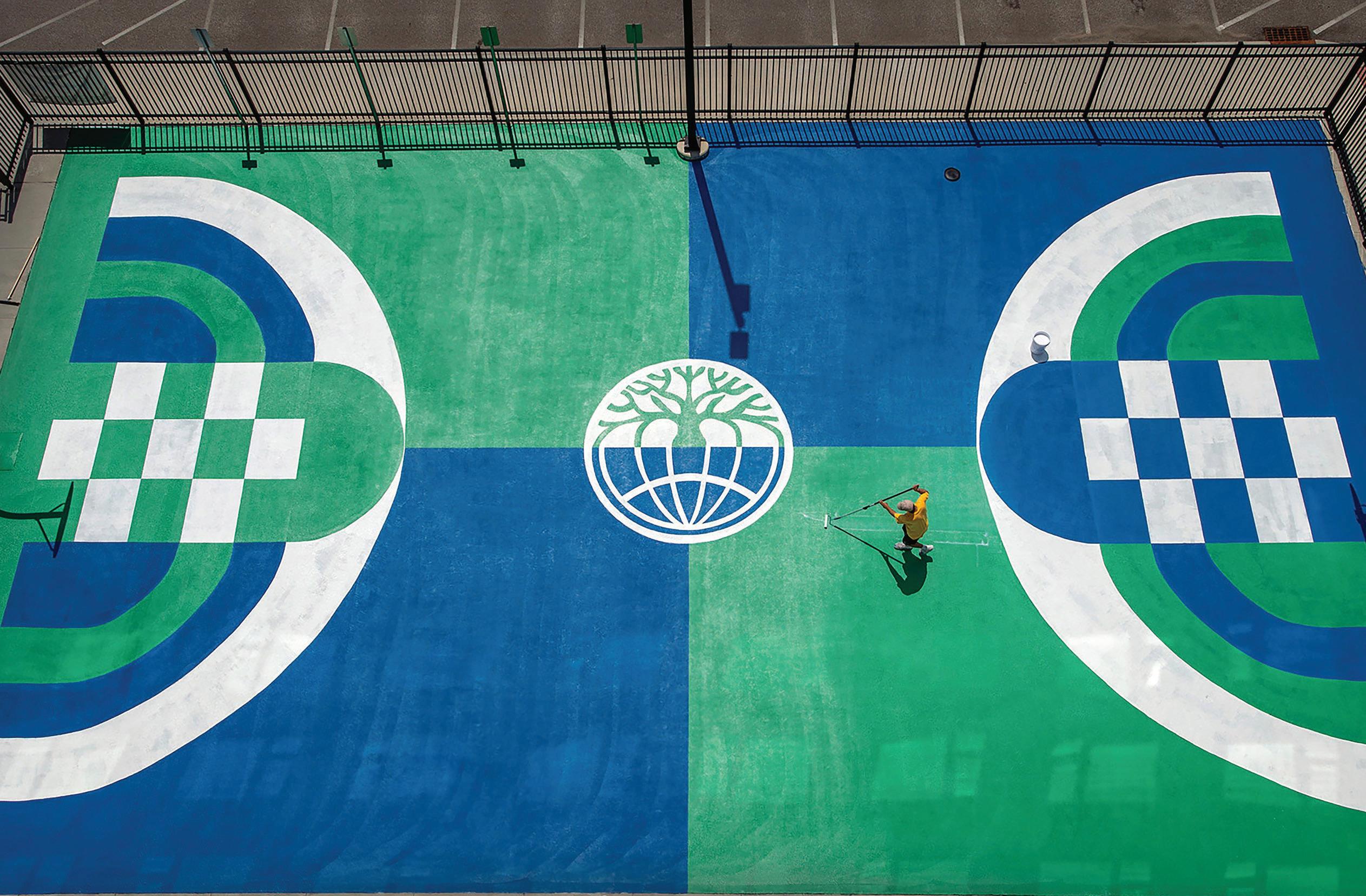


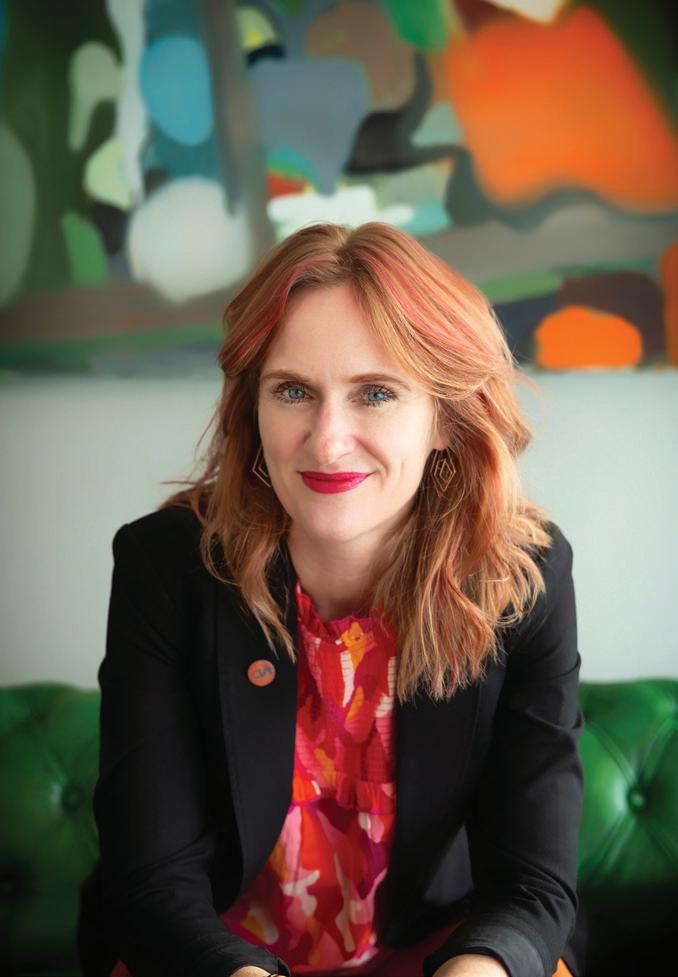
As I write this, I find myself in awe of the fact that I’ve now wrapped up my third academic year as President + CEO—and sixth academic year—at CIA. Although I may have a few new wrinkles to show for it considering the gale-force headwinds facing the higher education sector (including art and design education), I remain grateful, optimistic and inspired.
There is much that we’ve accomplished this past academic year that’s worth celebrating. CIA continues to push forward, evolve and engage in learning and continuous improvement. We’re looking hard at our organization from the inside out, prioritizing business model transformation and organizational resilience, futureproofing our curriculum, “growing the pie” to amplify the value of an art and design education across sectors, and enhancing CIA’s value proposition as a creative catalyst of regional innovation.
On that note, in this issue you’ll learn a little bit more about Creativity Works, a program that provides handson application of artistic practice into community practice, develops
student leadership and self-designed entrepreneurial skills, and makes a collective impact on the region’s community development ecosystem. These factors are critical to “cultivating creative leaders” and “contributing to a thriving and sustainable economy,” both which are essential components of CIA’s mission.
I’m also proud of the learning that our faculty, staff, and students are exploring with respect to artificial intelligence in both teaching/learning and business operations. While our institutional philosophy certainly does not “endorse” AI, it’s important that we continue to learn to understand emerging technologies, advance digital literacy and access, and do so ethically and responsibly. And as we look toward the future—especially amid the age of AI—the “future of work” needs CIA’s human-centered creativity and design mindset more than ever.
In May, the Cleveland Foundation held its grand opening celebration to launch its MidTown Collaboration Center, which is home to CIA’s Interactive Media Lab. (The IML’s “official” opening will coincide with the start of fall semester.) All eyes are on Cleveland—and on CIA—as we position ourselves as an essential anchor of what might possibly be the nation’s most unique and innovative cross-sector ecosystem. “Cleveland’s coolest watercooler,” as I like to call it, will foster creative collisions between arts/design, technology, workforce development, entrepreneurship, education, health/medical and hospitality industries. And CIA is at the heart of it all, with a prominent seat at the “big kids” table. Cheers!
Summer 2025 Vol. 28, Issue 3
Helping alumni and friends of Cleveland Institute of Art remain informed of campus, faculty and alumni news. CIA publishes Link four times a year.
Copyright © 2025 Cleveland Institute of Art
Kathryn J. Heidemann President + CEO
Kathryn J. Heidemann President + CEO
Malou Monago Vice President of Institutional Advancement + External Relations
Michael C. Butz Director of College Communications + External Relations
Rachel Zinram Director of Alumni Relations + Scholarships
Stephanie Zolton Publication + Communication Design Specialist
Submit ideas and updates for Link: Mail Cleveland Institute of Art 11610 Euclid Avenue
Email link@cia.edu
Phone 216.421.7412
Compiled by Michael C. Butz
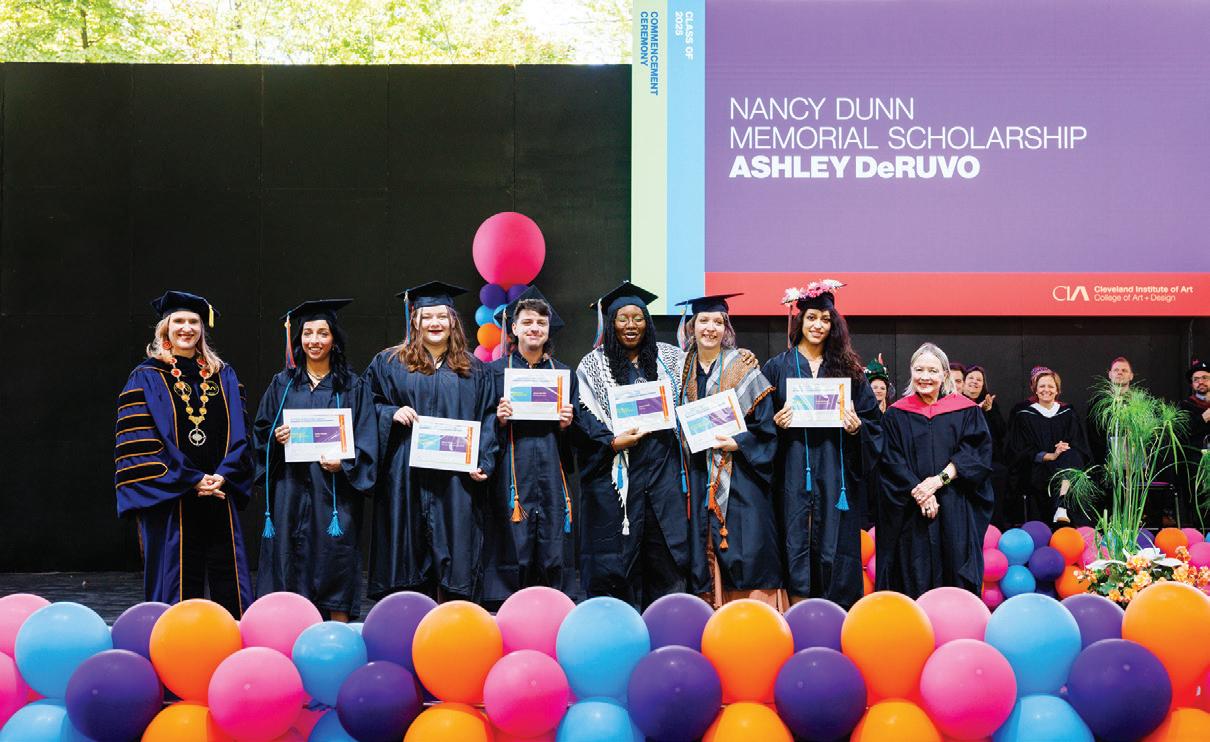
This year’s President’s Traveling Scholarship recipients were announced during Commencement. They receive funds toward travel that allows them to dive deeper into their creative process. Congrats to Annie O’Brien ’25, Glass (First Agnes Gund Award); Casey Wehrman ’25, Sculpture + Expanded Media (Second Agnes Gund Award); James Schaffer ’25, Drawing and Painting (Third Agnes Gund Award); Jazzee Rozier ’25, Drawing (Helen Greene Perry Traveling Scholarship); Gwen Putz ’25, Printmaking (Mary C. Page Memorial Scholarship); Ashley DeRuvo ’25, Interior Architecture (Nancy Dunn Memorial Scholarship).
Alumni Exhibition now on view at CIA
Proudly presented by CIA’s Reinberger Gallery and Alumni Council, and curated by visiting Roulet-Hernandez Family Curator Maria Seda-Reeder, the 2025 Alumni Exhibition— Holding Up the Mirror—explores our present moment and reflects the various ways artists imagine new paths forward for humanity while holding space for truth, change and collective care. The exhibition features work from 38 CIA alumni representing 60 years of graduates, from 1965 to 2025. The exhibition is on view through August 8 in Reinberger Gallery.
Students, faculty, staff, Board members and donors gathered April 22 to mark the opening of Nunes Student Plaza. Upon his retirement in 2022 as CIA’s 10th president, Grafton Nunes sought to create a green space on campus that could be enjoyed by the CIA community. As a result of his vision, and thanks to donor generosity and student input, Nunes Student Plaza—located along Euclid Avenue on the northeast corner of CIA’s campus—now serves as a place to gather and connect.
CIA faculty and staff recognized, honored and more
As the 2024–25 academic year came to a close, year-end awards and honors were bestowed on CIA employees. Foundation professor Kevin Kautenburger and former Photography faculty member Barry Underwood received 2025 Viktor Schreckengost Excellence in Teaching Awards, which are presented to current and/or former faculty members in recognition of teaching excellence at CIA. Liberal Arts senior professor of practice Scott Lax received the 2025 Dan Tranberg Excellence in Teaching Award, which is presented to current non-ranked faculty.
In other faculty news, Kautenburger, Craft + Design professor Gretchen Goss and Industrial Design professor Doug Paige ’82 all retired in 2024–25. Underwood and Craft + Design faculty member Kathy Buszkiewicz were granted emeritus status.
In addition, CIA’s Staff Impact Awards were given to recognize and celebrate the contributions of staff members who go above and beyond to support CIA’s mission, values and the overall success. Zack Frazier, Manager of Digital Transformation + Administrative Systems, and Megan Stanevich, Assistant Director of Continuing Education + Community Outreach, earned this year’s awards.
The Cleveland Institute of Art’s Interactive Media Lab was the center of attention during the Cleveland Foundation’s grand opening block party for its MidTown Collaboration Center. The IML is housed inside the MCC, and the event offered attendees—including Ohio Gov. Mike DeWine and Cleveland Mayor Justin Bibb—a first look at the IML’s state-of-the-art XR Studio.
CIA Industrial Design and Animation students have already started on a project to learn more about the XR Studio’s capabilities, and the IML is hosting summer camp students from the Fatima Family Center’s nearby campus in Cleveland’s Hough neighborhood. The IML will fully open when CIA’s fall semester begins in August.
Carole Eidenmiller ’53 studied Fashion Design/Fashion Illustration and passed away February 9. Daniel Buckley ’61 graduated from Industrial Design and died April 25. William Wayland ’65, who studied Industrial Design, passed away February 19. Daniel Postotnik ’84 majored in Ceramics and died May 9. Rebecca Oerkfitz-Garcia ’03 studied Fiber + Material Studies and passed away May 12. John Chuldenko Sr., who was a CIA faculty member for 35 years, died in late March.
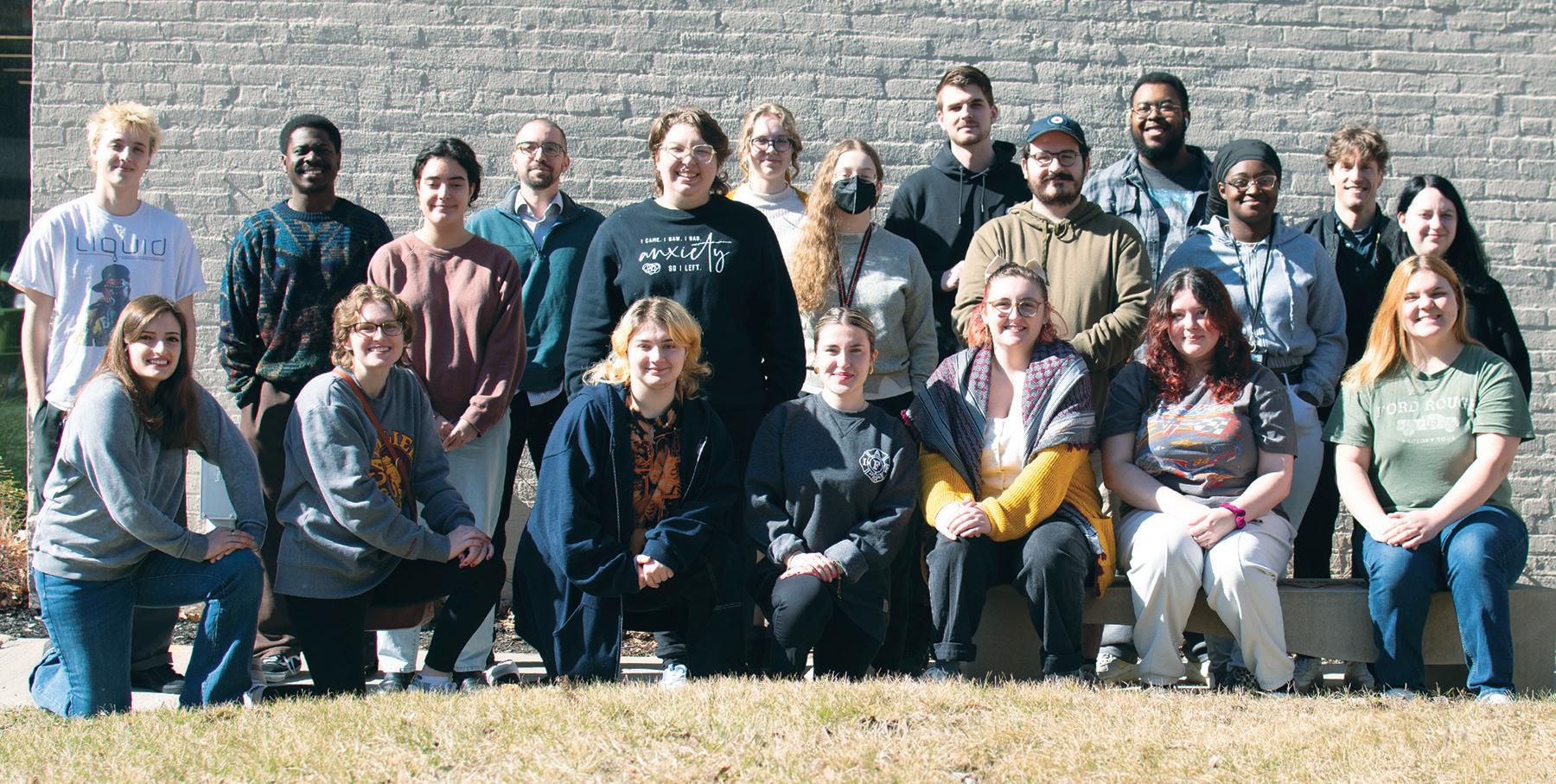
By Carlo Wolff
On a rainy morning in early May, Cleveland Institute of Art students gathered in CIA’s Nunes Student Plaza for their first glimpse of 11:59, a 168-page student magazine of writing, art, sculpture, design, philosophy and more. The occasion was a delight for Charlotte Smoley, an Interior Architecture major who with classmate Annie Koppitch was in charge of “experience design and promotion” for the magazine.
“When I first held 11:59, I felt pride and connection,” Smoley says. “Seeing the creative work of fellow students in a professionally produced format was inspiring, and it made me even more excited about contributing to the design world. It reminded me how powerful visual storytelling can be.”
And how such storytelling can build a powerful sense of community.
11:59 is the second iteration of an interdisciplinary venture launched by Adam Lucas and Zach Savich two years ago. Lucas is a Graphic Design associate professor, Savich a Liberal Arts associate professor. Each had different ideas about the campus-wide project. Its 2024 launch was a 182-page magazine called Ctrl+S. But in 2025, instead of calling it, say, Ctrl+S 2.0, they opted for a more open-ended numerical sequence.
“11:59 brings to mind both deadlines and the start of a new day,” Savich says. “It suggests the urgency of the last minute and the threshold of what’s next.”
“The creative process of developing a literary magazine is a natural extension of the art and design students are producing on campus,” says Yvette Sobky Shaffer, Vice President of Enrollment Management + Marketing at CIA. “This magazine is an extension of the professional ways students will be amplifying their work when they graduate. Learning how to curate for the printed page and to tell their stories is applicable to all of our students.”
At CIA, that learning comes from Lucas’ Publication Design course and Savich’s Publishing Workshop, both electives.
“We saw that students at CIA are excited about publications, from zines to artists’ books to editions of students’ work,” Savich says. “We saw this interest inside and outside of classes, including from the many students in the Creative Writing minor.
“Adam has an amazing background in book design and publication across settings. My background includes work in editing and publishing. We work collaboratively as faculty— just like students do on the magazine.” Savich is particularly
gratified that 11:59 is the College’s summer reading selection for new students this year.
11:59 is page after page of art and design, touching on topics such as botany, photography, gender, fantasy-funny figurines, food, interviews about work, organisms natural and unnatural, politics, car design, furniture, medical illustration, autobiography—it goes on and on, captivating the reader with imaginative typography, creative layouts, provocative prose and graphic diversity.
According to Savich, the magazine is the distillation of 250 submissions. They included work from BFA projects and courses at every level, along with creative work from outside the contributors’ majors.
Lucas and Savich want their students to develop critical thinking and creative problem-solving, especially within the context of a collaborative, long-term project. “This will benefit any student during and after their time at CIA,” Lucas says.
“I took this class hoping to dip my toe into the publishing world,” says Smoley. “One of the best parts about being able to take courses outside of my major is recognizing the overlap across creative fields. In college, it’s easy to become focused solely on your own path, but stepping outside of that bubble can be incredibly inspiring. For me, that’s exactly what happened, and I saw my work improve.”
Collaborative
Smoley says she loved being “executive lead” on 11:59, “overseeing how we would launch the magazine and get it into students’ hands. I focused heavily on engagement, which included a fun tote bag giveaway and a bookmark-making station. The goal was to make the launch interactive and inviting, encouraging students to connect with the magazine in a hands-on way.”
“The main part of 11:59 I found most rewarding was the community cultivated through the magazine,” says Koppitch, an Animation major set to graduate in 2026. “At the launch event, I noticed students socializing with each other and showing off their own personal contribution to the magazine, all while creating a brand-new piece of art via our bookmark making session. I felt this same satisfaction when I flipped through the pages of 11:59 for the very first time—though there were mishaps and setbacks along the way, I felt we’d captured a variety of voices in the final piece that truly represents the strong community here at CIA.”
“There are so many variables and complexities to a semesterlong project like this, that twists and turns—and at times surprises—are inevitable,” says Lucas. “It’s what makes teaching and learning in classes like this so fun and dynamic. You have to think on your feet, make informed decisions under pressure, and build trust in each other.”
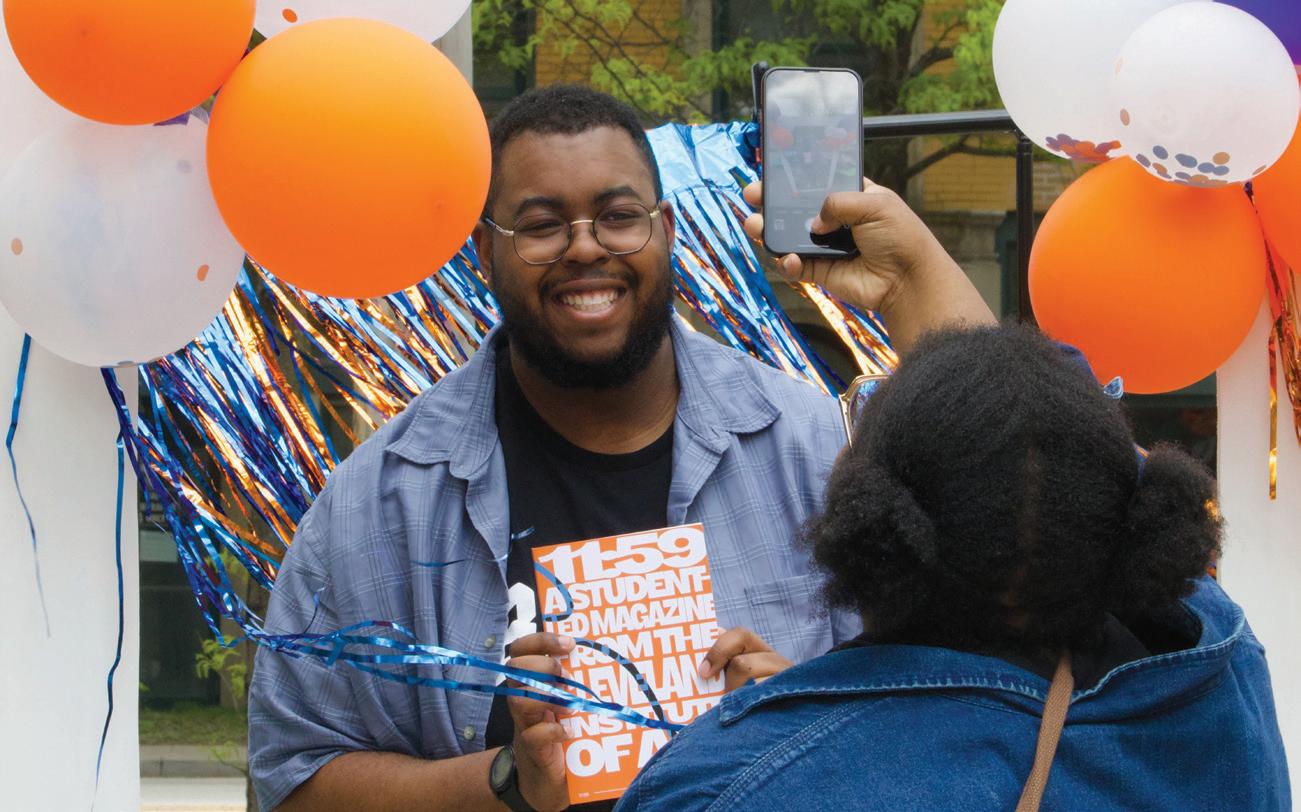


“Creativity often means making new connections,” Savich says. “Art expands how we see, and that expands how we can think. It helps us be together in new ways. That’s exactly what happens in a publication. You select pieces to feature, and something new emerges through the gathering. You see meaningful connections across pieces and experiences. It helps us all understand what it means to be an artist, designer or creative writer at this moment.”

By Michael C. Butz
Throughout the 2024–25 academic year, a team of Cleveland Institute of Art faculty participated in the American Association of Colleges and Universities’ inaugural Institute on AI, Pedagogy, and the Curriculum. The year-long, fully online institute aimed to help colleges and universities respond effectively to the challenges and opportunities artificial intelligence (AI) presents for courses and curricula.
By participating, the CIA contingent hoped to develop an action plan that keeps sustained focus on AI-related matters at the College. Importantly, they hoped to talk to peer institutions about what’s working and what’s not. But, something was missing.
“[CIA was] the only stand-alone art and design school in the AAC&U institute,”
says Kari Weaver, director of CIA’s Jane B. Nord Center for Teaching + Learning, who subsequently reached out to the Association of Independent Colleges of Art & Design (AICAD) in an effort to build those missing connections.
“I spoke with Deborah Obalil, executive director of AICAD, and we talked about starting cross-institutional conversations amongst AICAD schools about AI. We want conversations with our peers ... and [CIA is] going to lead the AICAD conversations.”
Leading the conversation—literally—is where CIA wants to be when it comes to AI. President + CEO Kathryn Heidemann believes it’s imperative that CIA be at the forefront.
“CIA has been an innovator for almost 143 years, and innovation often happens
amid disruption of the status quo,” Heidemann says. “When it comes to AI, we can choose to get ahead of it or get run over by it—and in our case, we have the opportunity to be trailblazers in AI integration and to do so ethically, responsibly and in line with our institutional values.”
“I think we’re taking leadership in the critical exploration of [AI],” Weaver adds. “That’s my aim, and that’s part of where the committee was really landing, too. I feel like we’re distinguishing ourselves as critical thought leaders.”
The “committee” to which Weaver refers is CIA’s AI in Creative Practice Committee, which includes faculty members Jimmy Kuehnle (Sculpture + Expanded Media), Scott Ligon (Foundation), Suzie McGinness ’07
(Illustration), Jason Tilk ’97 (Industrial Design) and herself (Liberal Arts). Together, they represent each of the College’s five academic divisions— and it was this team that participated in the AAC&U institute.
“I really was curious about what other institutions and faculty had to say,” says Kuehnle of his AAC&U Institute experience. “I was surprised. In my bubble, I thought everyone was knowing about these things. It was interesting to see a lot of other schools were in the not-even-trying-it phase.”
CIA’s AI committee spent much of its first year working to better understand students’ perspectives on AI. It’s a nuanced topic, to be sure, but students have primarily voiced concerns over infringement upon artistic ownership and environmental impact, the latter referring to increased demand for electricity to power computations and greater water consumption to keep machines cool. Students grapple with their environmental concerns regardless of whether it’s assistive AI, which is largely used to support people, or generative AI, which produces new content.
Students have also expressed they felt AI in the professional world is unavoidable and wondered how to retain their artistic identity while being prepared for practical expectations in the job market.
“One of the things I heard a lot about was wanting to make sure we uphold the expertise, craftsmanship and rigor of critical knowledge and creative

practices,” says Weaver of feedback she received from a Liberal Arts class that spent spring semester researching AI. “Even if not explicitly about AI, they’re worried about having community, having ethical labor practices and supporting intellectualism.”
With those concerns in mind, CIA approved an institutional philosophy regarding AI this past spring semester. The philosophy—cultivated over the course of a year by 11 faculty and staff members on the College’s Teaching + Learning Committee—doesn’t endorse AI itself but instead endorses learning and innovation around AI.
“We have a responsibility to do everything we can to advance digital literacy and future-proof both our curriculum and our operations so that students—and the College—don’t get left behind amid technological disruption,” Heidemann says. “Doing so is to embrace CIA’s institutional values of Accessibility, Responsibility and Excellence.”
Another of CIA’s forward-thinking approaches involves three new Jane B. Nord Center for Teaching + Learning faculty fellows who will focus on AI and emerging technologies during the 2025–26 academic year. Photography faculty member Charles Lee will focus on AI and Blackness; Liberal Arts adjunct faculty Troy Neptune will help with the AICAD cross-institutional conversations; and Foundation adjunct faculty Cullen Houser will continue to collect student perspectives.
In addition, starting in fall semester, students will gain more direction on how AI can be used in the classroom with the introduction of AI-specific syllabus statements.
“Faculty have ultimate agency. They can say, ‘we’re not using it in the creation, editing, testing of anything in this class—and this is why.’ Or, ‘you can use it for this, and you have to provide these prompts,’” Weaver says.
“[AI syllabus statements] should have a major impact on students, and it forces all faculty to look at it, examine it and take a stance on it.”
Kuehnle believes that CIA is poised to lead on AI in part because of the design process inherent to the College and the creatives who work and study there:
“I think CIA should embrace a position of leadership in the art and design world— and in education. We need to be embracing new technologies in a way that allows us to have a voice in how they’re used and how the next generation uses them.
“We’re an institute of higher education. We should have open inquiry, we should know things and we should experiment with new things,” he continues. “Part of our mission is the creation of new knowledge, not just the dissemination of knowledge. Otherwise, you stagnate.”
With an eye on the future, Heidemann recently enrolled in the Managing AI Systems graduate certificate program at Carnegie Mellon University, which is home to U.S. News & World Report’s No. 1 ranked AI program. The year-long program focuses on design-centered, systems-minded, ethical and responsible AI integration to drive organizational change.
Already, though, Heidemann understands that CIA will figure prominently in influencing how the world interacts with AI. “In the age of AI, the role of artists and designers—and their uniquely human-centered skills in creativity and complex problemsolving—are more crucial than ever.”
Weaver agrees that CIA is positioned to lead on AI because of art and design’s focus on the human experience.
“This is an opportunity to really focus on what it is that humans do very uniquely. You’re thinking about what this technology is capable of doing—but what it’s not capable of doing, that’s uniquely human,” she says. “I think creative industries are poised to help us navigate this era of greater access and use of AI because we are focused on those human experiences. It’s made me really think about what a creative education could be in broader ways at this exact period of time. People are seeking a deeply human experience.”
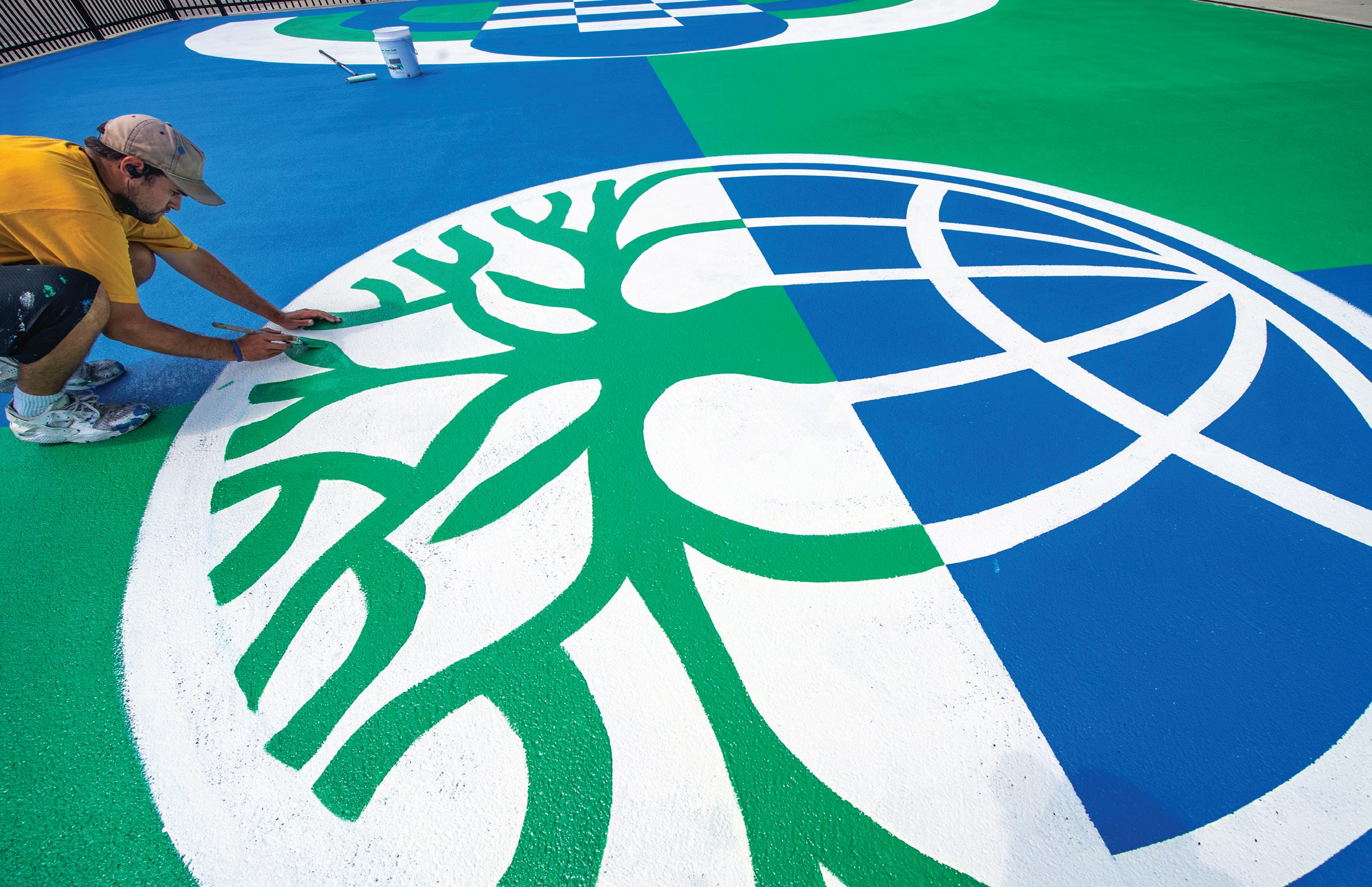
By Karen Sandstrom ’12
It’s lunchtime on a chilly April day when Nick Birnie ’21 props his cellphone on the floor of a scaffold, then conducts a video interview while he paints an advertising mural on the side of a building.
Mural-making is Birnie’s full-time job.
“Every day is a little different and presents its own challenges,” says Birnie, who lives and works in Brooklyn, New York. “Walking into something new every day is always exciting, and I like working outside and being around people.”
Birnie traces his love of mural work back to his days as a Drawing major at CIA. During a junior-year internship, he enlivened a basketball court at the Campus International School in Cleveland with a bold, customdesigned paint job.
The experience helped provide a doorway to Birnie’s career as a painter and foreman for Colossal Media, which specializes in hand-painted outdoor advertising and public art. And opening doors is exactly what the internship was
to do.
Ten years ago, the five-member inaugural cohort of CIA’s Creativity Works program completed their projects for collaborating community organizations that had taken them on as interns. The students were juniors focused on developing careers as studio artists. They spent months conceiving ideas; drafting project budgets, timelines and marketing plans; learning and building communication skills; and, of course, making the work itself for a public exhibition or project.
By 2025, Creativity Works had expanded to 21 students, thanks to growing enthusiasm and to crucial funding from the Fenn Educational Fund and G.R. Lincoln Family Foundation.
Creativity Works was the brainchild of Maggie Denk-Leigh, professor in the Printmaking program. She wanted students who hoped to thrive as studio artists to gain relevant work experience, as those in applied-arts majors did.
“Creativity Works supports primarily visual arts and Craft + Design majors. We had all of these really amazing students with all this potential, but they weren’t having internship opportunities,” says Denk-Leigh.
“Creativity Works put a spotlight on that need in Cleveland, a community that is already so welcoming and supportive to creative individuals.”
Each artist receives a $1,000 budget, guidance from an academic project leader—usually a faculty member— and support from CIA marketing and communications experts.
In recognition of a decade of Creativity Works opportunities, we interviewed four alums about the value of their experiences.
Nick Birnie ’21
It was fall of 2019 when Birnie’s interest in Creativity Works was piqued during a Lunch on Fridays presentation by students who had completed their internships the previous spring. He worked with Drawing faculty member Amber Kempthorn, his project leader, on ideas and potential collaborators.
Birnie was in talks with a local arts facility when the COVID-19 pandemic hit, closing nearly everything— including that potential collaboration.
With help from Kempthorn, Denk-Leigh and others, he connected with Campus International, a K–8 magnet school in Cleveland, where the tired basketball court badly needed a refresh.
Five students participated in Cleveland Institute of Art’s Creativity Works program when it launched during the 2014–15 academic year. Their projects were held at places such as the Great Lakes Science Center, University Hospitals and in the Waterloo Arts District—all in Cleveland.
In 2024–25, a record-high 21 students took part, building off two years in which 14 students participated. Projects in recent years have taken place (or are scheduled to take place) at places such as the Holden Arboretum in Kirtland, the Fairmount Center for the Arts in Russell Township and the Madison Public Library—all outside of Cuyahoga County.
In other words, Creativity Works has grown in both participation and geographic reach. That’s a big deal.
The program has also grown in less-quantitative—but no less significant— ways. For example, students have long hosted solo exhibitions and curated group exhibitions. But in recent years, there’s been an uptick in painting murals and leading workshops.
“Since COVID, we’ve done a lot more workshops,” says Maggie Denk-Leigh, Creativity Works founder and Printmaking professor.
“This is something really interesting to the students, to work with an organization to run a making workshop at the organization. They bring their tools and their skills, and then run something,” she says. “So, it’s really still fulfilling that external realization of their studio-based work. When the community receives them, it’s met with such validation—which has always been part of the program.”
Growth in student development through Creativity Works has also come from a change in how budgets are discussed and taught. In the past, students worked individually with their academic project leaders. These days, all the students going through the program meet together.
“So they’re all struggling and problem solving at the same time, which makes them feel part of an organization,” Denk-Leigh says. “They feel part of a project, which was really good. And they actually are doing really well in terms of problem solving for each other and also lifting each other up.”
That sense of community and cohesiveness then permeates the Creativity Works experience.
“And then they also show up for each other. They go to each other’s events, they participate in each other’s things so that the student has a built-in network,” Denk-Leigh says. “They’re doing things for the first time, so they’re nervous and there’s anxiety. Having their peer network with them has helped a ton.”
Birnie originally hoped students and families could participate in the painting, but when the pandemic scotched that, he had them vote from a selection of designs he created for the court.
– Michael C. Butz
“That was what they were looking for from me, and it allowed me to remove any ego from the project,” he says.

Birnie faced other hurdles as well. After researching materials, he learned the court needed to be resurfaced before it could be painted. The cost of the resurfacing killed his budget, so it was time to get resourceful. He sought and received a contribution from a former employer as well as from Sherwin-Williams, the Cleveland-based paint company.
Campus International teacher Kate Grzelak was Birnie’s project liaison.
“Nick Birnie’s incredible work through the Creativity Works program has transformed the basketball court at Campus International School into a vibrant reflection of our school pride, perfectly capturing our colors and logo,” she says.
Amid the pandemic, the technical challenges and the budget hurdles, the project tossed Birnie plenty of learning opportunities. That’s why he considers the program so valuable.
“The main takeaway was the amount of logistical planning that goes into a project,” he says. “I think I did 200 hours of work before paint touched a surface. And what stays with me to this day in my career is that we’re always on deadlines.”
When the Creativity Works internship applications opened in fall of 2022, James Negron already knew what he wanted to do: dog sweaters.
Negron’s project was the Warm Wait Mission, a four-month series of free crochet workshops, where attendees made granny squares that were then used to make dog sweaters. The project helped raise money for an organization that aids residents in need by providing health care and other resources for their pets.
These days, Negron is a visual arts teacher at Rainey Institute and works as development and newsletter manager at CAN Journal. His mixed-media work has been exhibited at a number of galleries in Northeast Ohio.
Negron, who studied Sculpture + Expanded Media, had started to crochet the previous year and became “completely obsessed” with learning to make garments. In his workshops at CIA, he taught students to crochet, supplied materials, and then donated the sweaters to Neighborhood Pets in Cleveland’s Slavic Village neighborhood.
“The idea of hosting crochet workshops and making pet sweaters was inspired by my own dog, and the understanding that financially supporting a pet can be difficult,” Negron says. “I was searching for local shelters to work with and found Neighborhood Pets’ website. I felt a strong connection to their mission and emailed them with information about my proposal. (They) were so kind and willing to help me navigate the obstacles we encountered along the way.”
The collaboration went well for Neighborhood Pets, too, says Becca Britton, Neighborhood Pets’ executive director. The organization serves 9,000 households across Cleveland, providing access to affordable pet care for people with financial needs.
“James was a great project manager, and we were thrilled at his flexibility on creating a project to help the families and pets that we serve at Neighborhood Pets,” Britton says.
Negron made 30 to 40 pet sweaters, sewed dog beds for a raffle benefiting the organization’s Pet Aid Fund, and created a calendar featuring clients’ pets modeling the sweaters.
Business tasks—creating the project description, budget and timeline— have helped him grow as an artist. “These are documents that I still reference when applying to new grants and shows,” he says.
When El Arvizu applied for a Creativity Works internship in 2022, he saw it as an opportunity to learn more about himself as a ceramics artist.
“I was really focused on challenging myself to work with traditional methods of ceramics,” Arvizu says. “So I was working with traditional methods like porcelain and plaster working. I wanted to try and make my own glaze. I wanted to test myself as a ceramicist.”
His project, an exhibition titled NOT A SIN, was a series of seven sculptures based on the seven deadly sins. It was presented at newsense projects, an artist collective and experimental art space in a Lakewood century home.
“At newsense projects, we have collaborated with different Creativity Works recipients over the years,” says Kristin Rogers, Arvizu’s collaborator. “El was fantastic to work with and produced an exhibition that was dynamic, thoughtful and deeply aligned with the gallery’s mission to blur the contours between art and domesticity.”
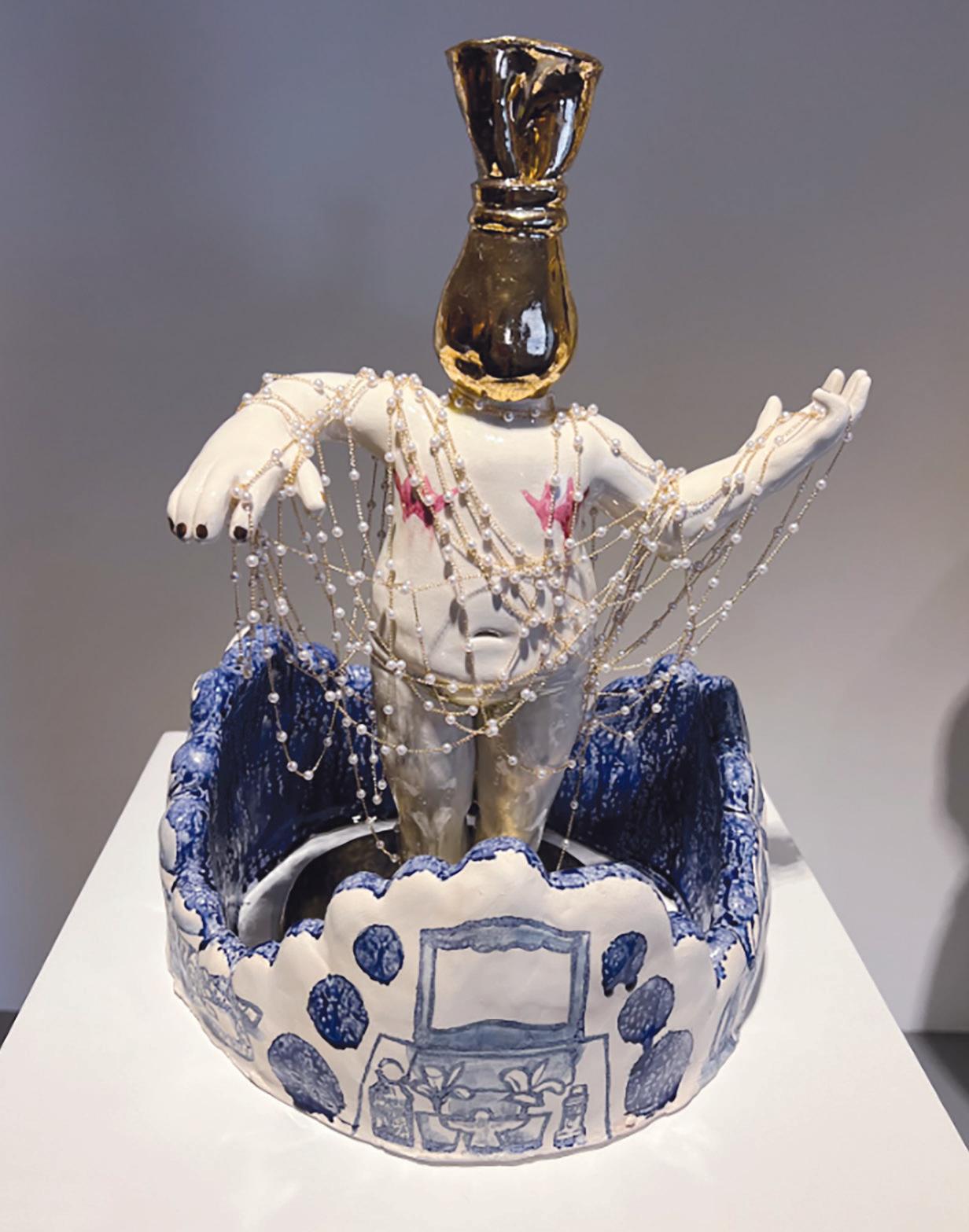
For Arvizu, the experience yielded artistic insights. The first was how much he loved making big work for a solo show. He liked making subjective work about self-inquiry.
“I’m the type of person that likes to look inward to try and fix the problems that I have to make myself a better person and to hopefully find a similarity with other people,” he says.
Arvizu’s project leader was Alberto Veronica Lopez, studio manager in CIA’s Ceramics program. The two connected over Mexican heritage and ceramics.
“We talked to each other a lot, and when I was doing Creativity Works, I was staying in the school from open to close,” Arvizu says. “He would see me come in, I would see him leave, and he would just be like, ‘So how’s the suffering going now?’”
For Arvizu, the experience held lessons about the grit required in committing to make a body of work and pushing on even when problems arise—such as a few parts that broke off some of the figures depicted in the “sins.”
“A couple of figures didn’t have pinkies, and people were like, ‘Is that an intentional thing?’ I was, like, ‘The intentionality is that the piece showed up. That pinky’s not there, and I can’t find it in the kiln, so we’re not going to talk about it,’” he says with a laugh. “That was my direction during the talk (at the opening), after I had gone through this long spiel of each piece and what it meant to me as a person and how it defined me growing up.”
The business side of the project also held important lessons, he says. Learning to budget and approach people to speak about his art paid off when it was time to prepare for “an even greater thing,” as he puts it: Arvizu won a $15,000 Windgate-Lamar Fellowship, awarded each year by the Center for Craft to 10 graduating students exhibiting exemplary skill in craft. He completed his fellowship in 2024.
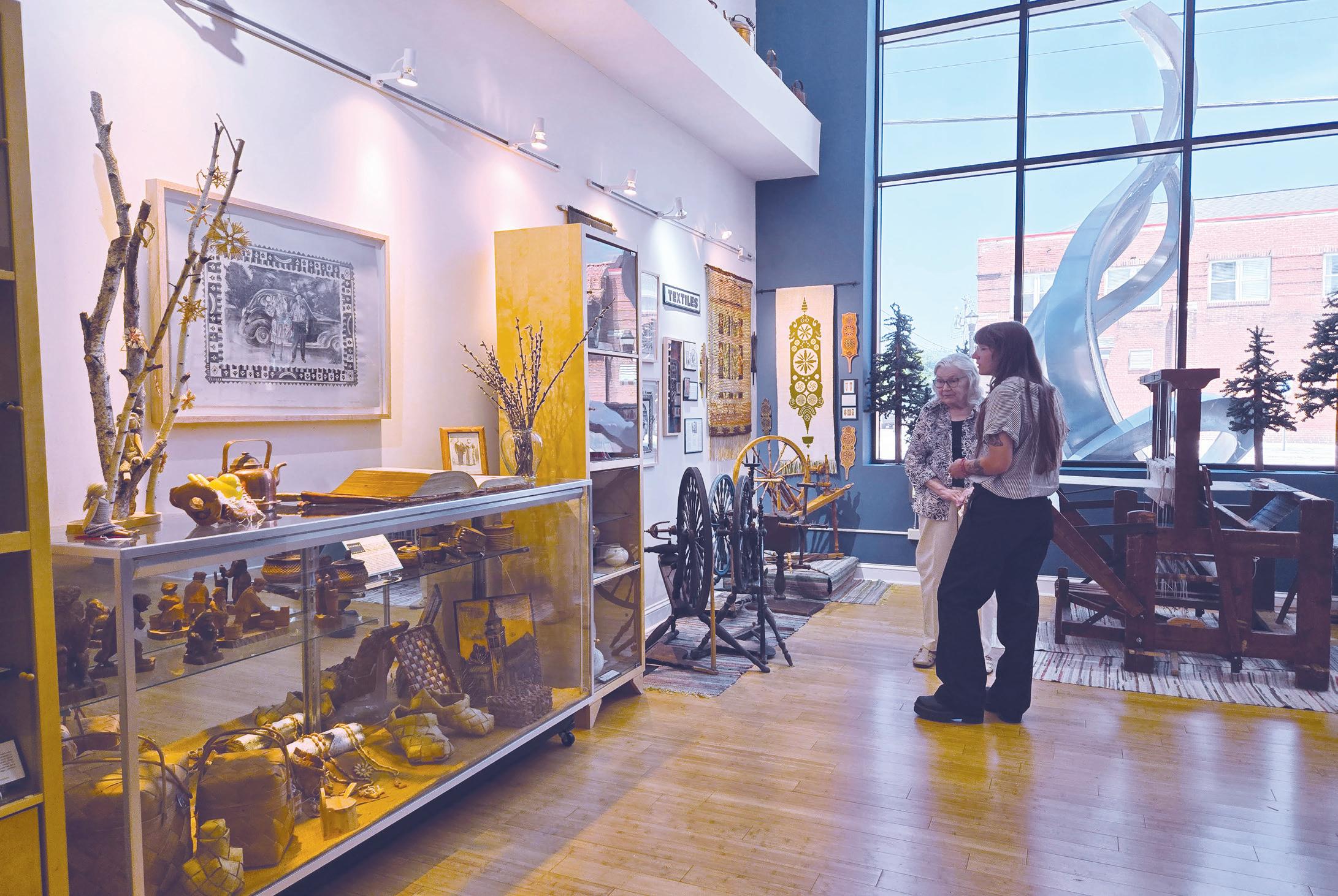
Gwendolyn Putz ’25
Printmaking major Gwendolyn Putz didn’t know much about Creativity Works until her junior year, when she attended a talk by the previous year’s cohort.
“Sitting and watching the other students present their topics, I immediately knew that not only was this something for me, but that I already had such a clear idea of what I wanted to do,” she says.
The project became an exhibition called Seeking Sisu: From Finland, with Love, a series of fine art prints based on photographs from her Finnish family background. They were presented at the Finnish Heritage Museum in Fairport Harbor, Ohio. The project evokes the history of her family’s displacement from the Karelia region in Finland by the Soviet Union in the 1940s.
Museum curator Janine LaBounty said it was a “joy” to work with Putz because of her passion for her heritage and her art.
“We would not have been exposed to her ideas, her passion, her artwork or her organizational skills without Creativity
Works,” LaBounty says. “We were all surprised by the fact that this was her internship, not the Cleveland Institute of Art’s, and that she had to develop it and make it happen. We would be so very happy if another student chose the Finnish Heritage Museum as a partner for their internship.”
Putz had always loved looking at family photos and listening to stories about her relatives.
“Something about the faces of past generations piqued my interest like nothing else, even before I was in college,” she says. “Coming from a unique family background was another aspect that added layers of interest to these photos. Hearing stories of my Mummi (grandmother) and Iso Mummi (great-grandmother) during times of war was shocking and brought a heavy feeling to much of what I saw in these albums. How did all these things happen? And how did I end up where I am? I started to question how the experiences of the women in my family affected our history.”
For the exhibition, she printed two editions of lithographs, one edition of etchings and a series of monoprints.
“The lithographs I printed were the largest I had worked with to date, around 22 x 30 inches. All the works were framed and presented alongside the cultural artifacts in the museum’s collection,” she says.
Putz continued the project for her BFA, and she says Creativity Works has been instrumental to the work she has developed since then.
“Something that was really important was the independence this project gave me. I came up with a lot of the answers to my own questions and really learned by doing,” she says. “There was still a really important balance held between guidance from my advisor and feeling like I was on my own, but this was the first time I really understood what my future in fine arts could look like, which was really exciting for me.”
Putz will join Ohio University’s Printmaking MFA program this fall.
By Kennedi Combs
In a sense, the Bundy family’s legacy of giving to the Cleveland Institute of Art began in the fall of 1968. That’s when Brian Bundy met Florence Carbone after being seated near her—alphabetically— as first-year students. What began as a seating arrangement quickly blossomed into friendship, and eventually, a lifelong partnership built on their shared appreciation for the arts.
“Art was our world, and the institution gave us a foundation of appreciation for the arts and design,” says Florence, who today is Florence Bundy. The couple married soon after graduation.
Florence and Brian earned BFAs in Graphic Design and Industrial Design, respectively, in 1973—and relationships they built with CIA faculty along the way were impactful. Brian was hired by former Industrial Design faculty Hugh Greenlee ’49 and Roy Hess ’48 at Greenlee-Hess Industrial Design, while Florence made a career as a graphic designer. The newlyweds stayed engaged with CIA through Greenlee and Hess and frequent visits to the College to view student exhibitions.
After Florence and Brian had two children, those visits to CIA became opportunities to introduce them to the world of creativity and expression provided by an art and design education. They shared the same wonder they once felt as students, nurturing in their children a deep appreciation for the arts. “We wanted them to learn and appreciate that
To explore how you can support CIA and its students, contact Rachel Zinram, Director of Alumni Relations + Scholarships, at rmzinram@cia.edu. If you’re ready to give, visit cia.edu/donate or use the enclosed envelope.

everything they see—everything that’s produced—was designed by somebody,” Florence says.
It worked.
“I really take after both of them,” says Brian Bundy Jr., the couple’s oldest child. “I remember always going to Dad’s office and building things. Even our school projects, they would always start out small, like something a fourth grader would do, and then because our parents were artists and would get really invested, it would end up being a college-level project.”
Those early experiences inspired Brian Jr. to follow in his parents’ creative footsteps. He earned his BFA in Graphic Design at CIA in 2005.
“I use what I learned at CIA almost every day,” says Brian Jr., who works as a freelance graphic designer. “I’m always thinking about ‘at CIA, this is how they would approach it’ or thinking of a specific technique I learned there.”
Brian Sr. passed away in 2011. Florence is now retired, but she and Brian Jr. continue to reflect on how their family’s formative CIA experiences shaped their creative paths and left indelible marks on their lives.
That profound impact has inspired them to give back over the years.
The family’s first gift to CIA dates back to 1980, meaning what started as a simple seat assignment has grown into an extraordinary legacy of generosity that’s lasted 45 years.
“It’s great to give back to something that gave us so much,” Florence says.
“We appreciated everything we learned at CIA. What the school taught us shaped who we are, and we still use those lessons every day.
“That’s why I think it’s so important to support the young artists coming up now, whether they’re designers, painters, commercial or fine artists,” she continued. “People should think back to their own time at CIA and remember what they gained. Even if you can’t give a lot, anything you contribute helps support the future of art.”
Compiled by Rachel Zinram
Clara Wolcott Driscoll (1880s*), James Modarelli ’38,* Charles Sallée ’38,* Betty Thatcher Oros ’39,* David Deming ’67, Marc Brown ’69, Paul Timman ’95, Zack Petroc ’95, Wes Burt ’04 and Clotilde Jiménez ’13 were featured in “10 Notable Cleveland Institute of Art Graduates You Need to Know” in Cleveland Magazine
Frank Wilcox 1910* has work in Frank Nelson Wilcox on view through June at WOLFS in Beachwood, Ohio.
Carl Gaertner 1924* had a solo exhibition, Exploring West Virginia: Sketches, Studies and Finished Works, in West Virginia Wesleyan College’s Sleeth Gallery in Buckhannon, West Virginia.
Dorothy Rutka Porter ’29*, Mary Lou Ferbert ’68,* Diana Bjel ’73, Leslye Discont Arian ’76, Marilyn Farinacci ’81,* Susan Squires ’83, Barbara Stanczak ’90 and Susan Danko ’98 had work in a group show, Nevertheless, She Created: Encore, at Bonfoey Gallery in Cleveland.
Hughie Lee-Smith ’38,* Charles Sallée ’38* and Curlee Raven Holton ’89 have work in Karamu Artists Inc.: Printmaking, Race, and Community through August 17 at the Cleveland Museum of Art in Cleveland.
Mark Greenwold ’66 had a solo show, The Human Condition, at Garth Greenan Gallery in New York.
Michael Tracy ’68* has a solo show, Michael Tracy: The Elegy of Distance, through July 27 at McNay Art Museum in San Antonio.
Diana Bjel ’73 and Deborah Silver ’21 had work in a group show, From WOMAN 18 in 2025, curated by Mary Urbas ’80, at UNDERSTORY in Cleveland.
*deceased

Barbara Cooper ’74 had work in a group show, A Tale of Today: Materialities, at Driehaus Museum in Chicago. Cooper also has work in Descending the Staircase through July 6 at the Museum of Contemporary Art in Chicago.
Jef Janis ’74 was the featured artist at Loganberry Books Annex Gallery in Cleveland.
Leslye Discont Arian ’76, Judy Takács ’86, Jaymi Zents ’97, Delinda Mariani ’99, Sarah Curry ’01 and Deborah Silver ’21 had work in From WOMAN 18 in 2025, curated by Mary Urbas ’80, at Lake Erie College’s BK Smith Gallery in Painesville, Ohio.
Julianne Edberg ’76 and Janus Small ’79 had work in a group show, Dimensional Delights, at the Beachwood Community Center in Beachwood, Ohio.
Beth Nilges-Nehamkin ’76 and Susan Gallagher ’91 had work in a group show, From Woman XVIII, curated by Mary Urbas ’80, at BAYarts in Bay Village, Ohio.
Pamela Pastoric ’77, Alan Mintz ’80, William Moore ’84, Judy Takács ’86, Eric Tuck-Macalla ’86, Sean Mabin ’93, Violet Maimbourg ’21 and Erjon Hajnaj ’23 had work in the 2025 Annual Juried Exhibition, co-juried by Mary Urbas ’80, at BAYarts in Bay Village.
Petra Soesemann ’77, Mike Meier ’10, Katy Richards ’11, Frank Hadzima ’23, Derek Walker ’23, Mason Kovacs ’24 and Tristen Kovacs ’24 had work in a group show, PROOF, at River House Arts in Toledo, Ohio.
Barbara Klar ’78 published her memoir, You’re So Talented: Confessions of a Worker B, available on Amazon. Klar also had four pairs of earrings included in the book New Earrings: 500+ Contemporary Jewellery Designs by Nicolás Estrada.
Susan Twining ’78 had work in a group show, Interwoven Aspects: Innovation and Tradition in Paper Art, at Morgan Conservatory in Cleveland.
Pamela Heller ’79 led the I Love You Project and hosted workshops at Arts Letters & Numbers in Averill Park, New York. Heller showcased the “I Love You Kiosk” during the Tulip Festival at Washington Park in Albany, New York.
William Reed Simon ’81 had a solo show, A Street at Dawn, at The Wine Spot in Cleveland Heights, Ohio.
James Esber ’84 had work in a group show, Authority Problem, at Satchel Projects in New York.

William Moore ’84, Dan Cuffaro ’91, Natalie Lanese ’05, Mike Meier ’10, Katy Richards ’11, Yiyun Chen ’15, Angus Luke ’15, Joey Goergen ’18, Alex Heard ’20, Alicia Telzerow ’20, Jace Lee ’21, Maxmillian Peralta ’21, Frank Hadzima ’23, Jordi Rowe ’23, Thomas Smith ’23, Alex Vlasov ’23 and Daly Horton ’24 had work in a group show, Love is Resistance, organized by Meier, Nikki Woods ’12 , Thomas Kassai ’16 and Seneca Kuchar ’24, at the Transformer Station in Cleveland.
William Moore ’84 won the Jurors Choice Award for his piece, “Avian Dancers,” in the 6th annual Artist of the Year awards and had a piece featured in Issue 41 of Spotlight magazine through Circle Foundation for the Arts in France.
Kenneth Marchione ’85 was featured as this year’s speaker for the Elizabeth Lemieux Faculty Lecture Series on March 27 at Pratt Munson College of Art and Design in Utica, New York.
Karen Beckwith ’87 and Kelly Pontoni ’19 had work in a group show, Retrospectively Speaking: 18 Years of Art Books Cleveland, at Pinwheel Gallery in Cleveland. Beckwith was also featured in a cleveland.com article regarding her solo show, Remnants, at Artists Archives of the Western Reserve.
Linda Zolten Wood ’87, Todd Hoak ’91, Angela Oster ’05, Lindsay Parker ’05, Kate Kisicki ’07, Lauren Chaikin ’09, Quill Kolat ’12 , Sequoia Bostick ’14, Deni Lance ’17, Susana Angel ’18, Fern Haught ’18, Max McMillen ’21, Thao Nguyen ’21, Marshall Pecora ’23, Jordi Rowe ’23, Tristen Kovacs ’24 and Liam Mealey ’24 had work in the 2025 DayGlo exhibition, Double Feature, Picture Glo, at Waterloo Arts in Cleveland.
Linda Zolten Wood ’87 hosted an artist workshop for Double Feature, Picture Glo at Waterloo Arts in Cleveland and was a featured artist at Stella’s Art Gallery in Willoughby, Ohio. Zolten Wood also led a rain barrel painting workshop hosted by the Slavic Village Development Corporation and Cuyahoga Soil and Water Conservation District in Cleveland.
Greg Martin ’89, Andrea LeBlond ’95, Lori Kella ’97, Amy Casey ’99 and Mike Meier ’10 were recipients of the Ohio Arts Council Individual Excellence Awards for fiscal year 2025.
Chris Lenart ’91 received the Good Design Award for the Atlas Pharmaceutical Testing Equipment (see photo on Page 15) and Magellan 9600i and Magellan 9900i Scanners with his company, lenartstudios.
Andrea LeBlond ’95 had work in the 20th Annual Ceramic Invitational at River Gallery in Rocky River, Ohio.
Lori Kella ’97 had work in Loving the Local: The Collection of David Burke at YARDS Projects in Cleveland. Kella also had work in a group show, Lens 2025, at Perspective Gallery in Evanston, Illinois.
Ann Toebbe ’97 was featured in an article, “Magic in the Mundane,” in The Wrap, where her work as a set designer for films Wicked, Emilia Pérez, Maria and Conclave was highlighted.
Susan Danko ’98, Timothy Callaghan ’99, Jeffrey Vincent ’02 and Katy Richards ’11 have work in Common Currents, on view through June 21 at the Artists Archives of the Western Reserve in Cleveland.

Amy Casey ’99 had work in a group show, LAND / SCAPE, at The City University of New York College of Staten Island’s Art Gallery in Staten Island, New York.
Irina Zavatski ’01 and Ryan Nagode ’03 presented their work on the Chrysler Halcyon concept car, Dodge Charger Daytona BEV and Jeep Wagoneer S BEV at the 2025 Cleveland Auto Show in Cleveland.
Jessica Calderwood ’01 hosted a workshop through the PlySpace residency program in Muncie, Indiana.
Jenniffer Omaitz ’02 and Natalie Lanese ’05 had work in a group show, Vibrancy, at the Mansfield Art Center in Mansfield, Ohio. Omaitz also had her work featured on the cover of a recent issue of Cleveland Magazine and has work in a group show, In Ohio, through July 2 at Riffe Gallery in Columbus.
Andrew Zimbelman ’06 produced an animated film, Life Like Violence, for composer and musician David Handler.
Nate Cotterman ’07 served as a juror for the 2025 Student Independent Exhibition at CIA. He also designed and produced Cleveland Cavaliers holiday gifts based on the team’s logo and Cotterman’s Cube Glass (see photo on Page 17).
Kate Kisicki ’07 had work in a group show, Art Show, at Door 2 Art Studio in Hudson, Ohio.
Nathan Margoni ’07 had work in a group show, A Retrospective, at The Acorn Center for Performing Arts in Three Oaks, Michigan.
Christine Kelly ’08 gave a poetry reading at the Clark Art Institute in Williamstown, Massachusetts.
Nicholas Moenich ’08 published an artist book, Ocean Size, available now on their website.

Sequoia Bostick ’14 and Amalia DeGirolamo ’14 were featured in the article, “Cleveland indie creators find room on shelves in crowded comics marketplace,” with WVXU News.
Emily Hromi ’14 had two original collages on display as part of a group exhibition, I Heart Recycled Art, at Cocoon Art Space in Grand Rapids, Michigan.
Onya Nurve (aka Justin Woody ’15 ) was crowned the winner of the 17th season of RuPaul’s Drag Race
Amber Ford ’16 is pursuing her MFA this fall at Carnegie Mellon University in Pittsburgh.
Davon Brantley ’18 was the artist-inresidence and had a solo show, Chapter 2: Midsommar in Granada Gardens, at Akron Soul Train in Akron, Ohio.
Fern Haught ’18 had a solo exhibition, Flocking Together, at Loganberry Books Annex Gallery in Cleveland.
Bianca Fields ’19 had a solo exhibition, Endships, at LaMontagne Gallery in Boston.
Alex Heard ’20 had work in Fresh: Perspectives from the SculptureX Network at The Sculpture Center in Cleveland.
Peyton Leatherman ’20 released a book, Bad Creek, through W. W. Norton & Company.
Violet Maimbourg ’21 won first place in the group show, Fresh: Soft Offerings, at Summit Artspace in Akron, Ohio. Maimbourg also had work in a group show, Metamatic, at Ctrl Gallery in Los Angeles.
Riley Rist ’21 had a solo exhibition, Covert Masculinites, at the 410 Project gallery in Mankato, Minnesota.
Sam Schneider ’21 is participating in a residency at Openbox in Brooklyn, New York.
Crystal Miller ’23 was a recipient of the 2025 Verge Fellowship through the Cleveland Arts Prize.
Jordi Rowe ’23 and Liam Mealey ’24 had work in a group show, I only had eyes for you, at UNDERSTORY in Cleveland.
Alex Vlasov ’23 self-published their first book, I’m Making Art (And Books!), available on eBay.
Wes Cunningham ’24 had work in Regional Perspectives at Heights Arts in Cleveland Heights, Ohio.
Janoi Daley ’24 had a solo exhibition, New Chapter, in the Horizon Gallery at Summit Artspace in Akron, Ohio.
Compiled by Michael C. Butz
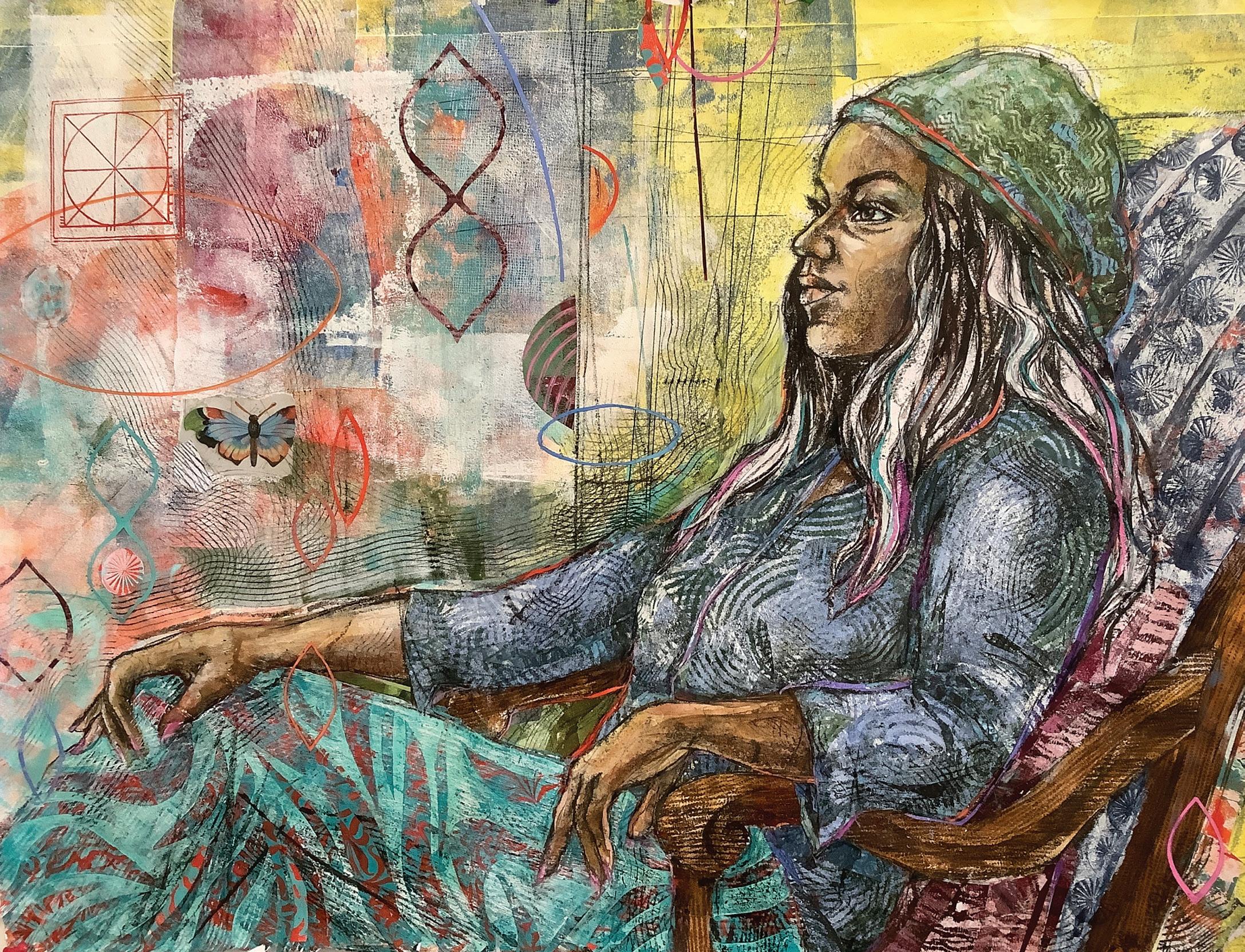
Nicole Condon-Shih (Foundation) was featured in the Next/Now exhibition at the Gillespie Gallery of Art at George Mason University in Fairfax, Virgina. Her work is also included in Common Currents, a co-curated exhibition jointly presented by the Artists Archives of the Western Reserve and the Burchfield Penney Art Center that will travel to Buffalo, New York for a summer 2025 showing. Additionally, she chaired a session titled “Pathways to New Models” at the 2025 Foundations in Art: Theory and Education (FATE) Conference at George Mason University.
Dan Cuffaro ’91 (Industrial Design) collaborated with Jeff Simonetta (Animation) on Project XR, a six-month effort to create CIA’s first virtual
production film. The project involved working with Animation and Industrial Design students, who pitched stories, wrote scripts, and designed physical and digital props and sets. The project will accelerate CIA’s ability to leverage the Interactive Media Lab. Cuffaro also was promoted to professor; participated in virtual production training over CIA’s winter and spring break; and ran a year-long effort to update the Industrial Design curriculum, supporting efforts by Jason Tilk ’97 (Industrial Design) to take a big-picture view of design at CIA.
Maggie Denk-Leigh (Printmaking) had work in Ink & Inspiration, a Rubber City Prints exhibition at Summa Health Gallery in Akron, Ohio, where she was recipient of the Art Acquisition Prize for
Healing Arts Fund; Love is Resistance at Transformer Station in Cleveland, curated by CIA’s Reinberger Gallery in collaboration with the Cleveland Museum of Art; a pop-up CIA faculty exhibition curated by Lane Cooper (Painting) at Waterloo Arts Café in Cleveland; and Color High II, a print exhibition organized by Rubber City Prints at White Rabbit Galleries in Barberton, Ohio.
Michelle Eisen (Academic Affairs) earned a scholarship to attend The New Centre for Research and Practice as a post-graduate certificate student. She will study critical art theory and applied philosophy of technology while working with program advisor Cécile Malaspina.
Elizabeth Hoag (Liberal Arts) gave a paper, “One Tough Mother: The Act of Mothering in the Field,” in honor of the trailblazing archaeologist Alice B. Kehoe during the annual meeting of the Society for American Archaeology (SAA) in Denver. She also served as a panelist in “Protecting Archaeologists: Safety at Work, School, and Beyond,” a forum sponsored by the Women In Archaeology Interest Group of the SAA, which she co-chairs.
Benjamin Johnson (Craft + Design) has work in Connections 2025: Glass from Every Angle, a Glass Art Society member exhibition in Arlington, Texas; the 102nd Annual Spring Show at the Erie Art Museum in Erie, Pennsylvania; Ohio Designer Craftsman’s Best of 2025 at the Ohio Craft Museum in Columbus, Ohio, where he won the Labino Award for Excellence in Glass; A Fine Line at the Sandusky Cultural Center in Sandusky, Ohio; and 99 Bottles at Florida CraftArt in St. Petersburg.
Jimmy Kuehnle (Sculpture + Expanded Media) has work in the Balloon Museum’s Pop Air, a traveling exhibition that will be on view through August 31 at the Marina Bay Sands in Singapore.
Scott Lax (Liberal Arts) introduced The Red Balloon and White Mane at the Cinematheque, after which he led an audience discussion. He also led a Lunch on Fridays conversation with actor and country musician Rob Mayes at CIA, and subsequently conducted a Q&A with Mayes following the Cinematheque screening of Mayes’ film The Neon Highway, co-starring Beau Bridges.
Nancy Lick (Illustration) exhibited two pieces in Cleveland Bouquet at Worthington YARDS. She also was part of a two-person show, Affinity in Life and Art, at Article Gallery in Cleveland.
Matthew McKenna (Information Technology) participated in a panel discussion, “Designing What’s Next: How Cleveland Institute of Art’s Interactive Media Lab is Shaping Tomorrow’s Creatives with FutureForward Tech,” alongside panelists from Disguise and The Studio—B&H during the National Association of Broadcasters (NAB) Conference in Las Vegas.
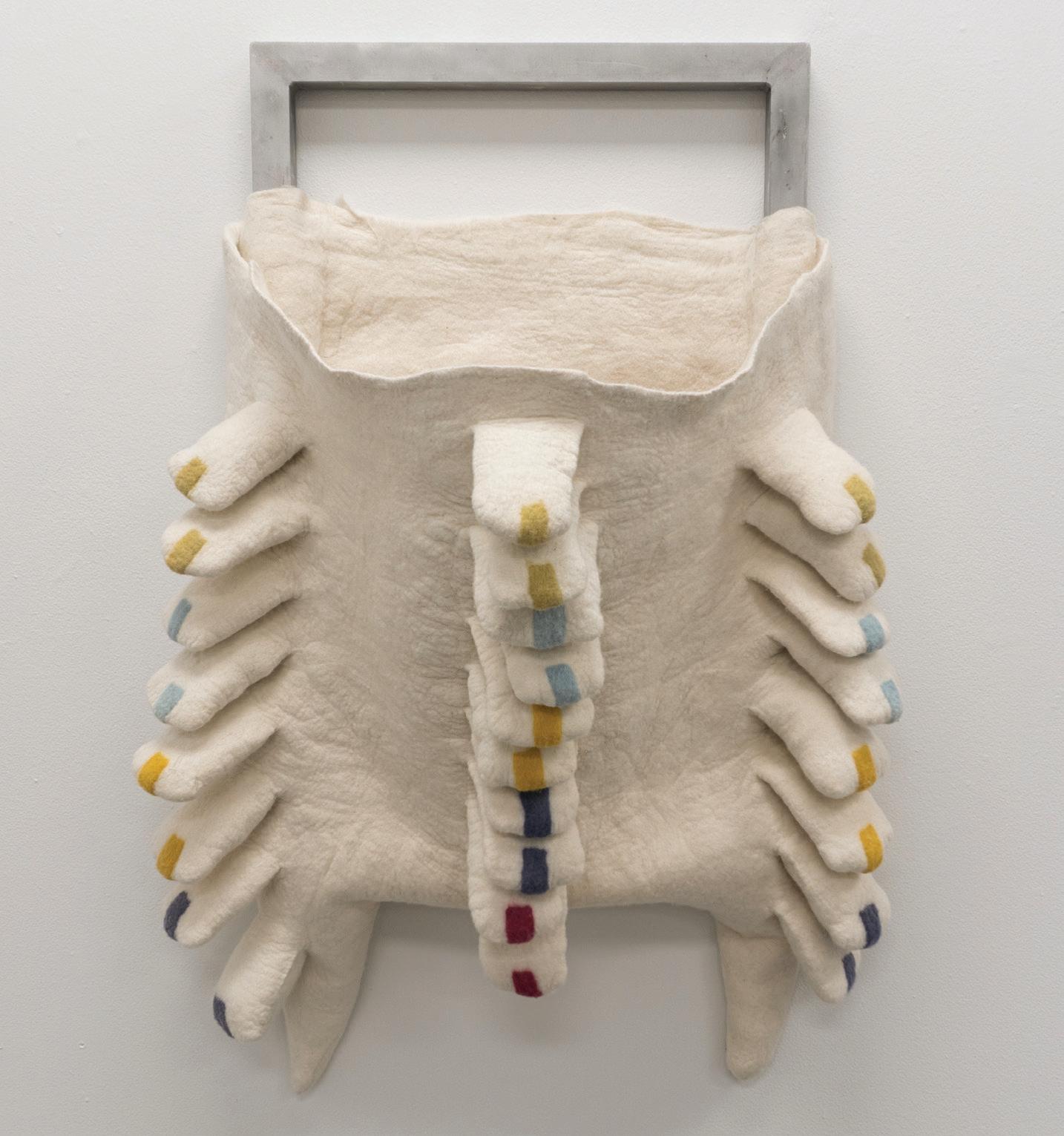
Sarah Paul (Sculpture + Expanded Media) will have a solo exhibition of a new Fiber Chamber in her storefront studio, sponsored by a Satellite Fund Grant administered by SPACES in Cleveland and supported by The Andy Warhol Foundation for the Visual Arts. She will also have a solo exhibition in Florida Atlantic University’s Schmidt Gallery in Boca Raton, Florida, from August through October. She also has work in International Fiber Arts XII at Sebastopol Center for the Arts in Sebastopol, California and Common Currents, a co-curated exhibition jointly presented by the Artists Archives of the Western Reserve and the Burchfield Penney Art Center that will travel to Buffalo for a summer 2025 showing.
Zach Savich (Liberal Arts) presented on panels at the College Art Association’s annual conference, the New Orleans Poetry Festival, and The Brooklyn Rail’s New Social Environment. His text for performance, A Field of Telephones, was published by 53rd State Press.
Pam Spremulli (Graphic Design) won the Fifth Annual Blossom Time Poster contest with her work, “Glow.” She also oversaw installation of “More than Everything,” a mural installed at the MidTown Collaboration Center in Cleveland’s Hough neighborhood that she designed in collaboration with Hough resident Lamar Abner.
Ariel Wills (Foundation) is a secondyear recipient of an AICAD Teaching Fellowship. She recently received a CIA Faculty Development Award. She will be a part of the inaugural portrait gallery exhibition, Founders and Inventors Who Shaped Our World, opening in September at @Gather_RI in Providence, Rhode Island.
She served as faculty sponsor for a visit by comics artist Marcel Walker, hosted in partnership with Cleveland Hillel at Case Western Reserve University for an Artist Lunch-and-Learn event at CIA. Recent projects include a custom collaged Ketubah, created in collaboration with Cleveland calligrapher Jennifer Kaplan, and an ongoing ceramics collection developed with local potter Bryce Boynton.
